|
|
|
Sort Order |
|
|
|
Items / Page
|
|
|
|
|
|
|
| Srl | Item |
| 1 |
ID:
147990
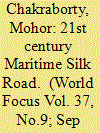

|
|
|
|
|
| Summary/Abstract |
The 21st Century Maritime Silk Road (MSR) is a cause for major concern in New Delhi as it provides a basis for Beijing to increase its geo-strategic footprint in the Indian Ocean. Notwithstanding the Chinese posture of allaying India’s concerns with respect to the massive outreach and implications of MSR, calling upon its neighbour to join the effort with a “friendly, open, cooperative attitude”, New Delhi has, naturally been cautious and calculative in making headway on the issue. Although Beijing had invited New Delhi to join the project in 2014, the Indian response has been negative.
|
|
|
|
|
|
|
|
|
|
|
|
|
|
|
|
| 2 |
ID:
170851
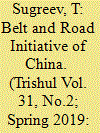

|
|
|
| 3 |
ID:
147993
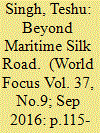

|
|
|
|
|
| Summary/Abstract |
The term Maritime Silk Road (MSR) was first used by Chinese President, Xi Jinping at the Asia Pacific Economic Cooperation summit held in Bali in 2013. Ever since then the MSR has become a major proposal of the new leadership in China. During Chinese Premier’s visit to Brunei, he announced the establishment of the China-ASEAN Maritime Cooperation Fund with USD 48 million allocated by China for sponsoring ASEAN-maritime cooperation projects. Further, to take this initiative forward China has set up a ten billion fund for this proposal.
|
|
|
|
|
|
|
|
|
|
|
|
|
|
|
|
| 4 |
ID:
139595
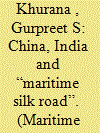

|
|
|
|
|
| Summary/Abstract |
In the coming years, the texture of China–India relations will be a crucial determinant of the geopolitical, economic and security environment of Asia, with a strong impact on the global order. Both countries have lately emerged as major economies. This has led to a dilation of their areas of maritime interest, and thereby a growing China–India interface at sea. This may be accompanied by both opportunities and challenges. Given the dynamism of recent developments, these need to be continually assessed and appraised as inputs for policy making. Among the most significant developments is China's “Maritime Silk Road” (MSR) initiative. In context of this development, this paper attempts to examine the convergences and divergences between China and India. While the bilateral divergences may continue to persist, the paper attempts to assess whether the two countries could capitalize upon the convergences to seize the opportunities presented by the MSR.
|
|
|
|
|
|
|
|
|
|
|
|
|
|
|
|
| 5 |
ID:
142121
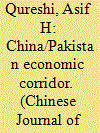

|
|
|
|
|
| Summary/Abstract |
This paper focuses on the China/Pakistan Economic Corridor (CPEC) arrangement between Pakistan and China from a legal and policy standpoint. It takes into account the Chinese Silk Road Economic Belt and 21st Century Maritime Silk Road Vision under which CPEC is set. The paper highlights the relevance of the application of both Pakistani law and international law to CPEC. In particular the paper focuses on some fundamental legal questions, for example the very legal character of CPEC. The discussion on the fundamental legal questions is followed by the various streams of legal frameworks that have a bearing on CPEC including the Pakistani Constitution and world trade and international investment norms. The purpose of this paper is to provide a framework of issues raised by CPEC. It is not intended as an exhaustive analysis of all the issues raised.
|
|
|
|
|
|
|
|
|
|
|
|
|
|
|
|
| 6 |
ID:
147106
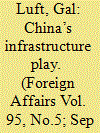

|
|
|
|
|
| Summary/Abstract |
Over the past three millennia, China has made three attempts to project its economic power westward. The first began in the second century BC, during the Han dynasty, when China’s imperial rulers developed the ancient Silk Road to trade with the far-off residents of Central Asia and the Mediterranean basin; the fall of the Mongol empire and the rise of European maritime trading eventually rendered that route obsolete. In the fifteenth century AD, the maritime expeditions of Admiral Zheng He [1] connected Ming-dynasty China [2] to the littoral states of the Indian Ocean. But China’s rulers recalled Zheng’s fleet less than three decades after it set out, and for the rest of imperial history, they devoted most of their attention to China’s neighbors to the east and south.
|
|
|
|
|
|
|
|
|
|
|
|
|
|
|
|
| 7 |
ID:
152981
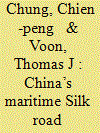

|
|
|
|
|
| Summary/Abstract |
This article focuses on China’s Maritime Silk Road initiative, paying particular attention to Southeast Asia, the initiative’s key focus. It examines the political and economic costs and benefits of participation in the initiative for Southeast Asian countries, and identifies the rationales that may enhance or diminish the initiative’s success.
|
|
|
|
|
|
|
|
|
|
|
|
|
|
|
|
| 8 |
ID:
186280
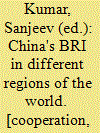

|
|
|
|
|
| Publication |
New Delhi, KW Publishers Pvt Ltd, 2022.
|
| Description |
xxviii, 359p.hbk
|
| Series |
Sapru House Soundings on Area Studies
|
| Standard Number |
9789383445646
|
|
|
|
|
|
|
|
|
|
|
|
Copies: C:1/I:0,R:0,Q:0
Circulation
| Accession# | Call# | Current Location | Status | Policy | Location |
| 060197 | 338.951/KUM 060197 | Main | On Shelf | General | |
|
|
|
|
| 9 |
ID:
154802
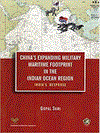

|
|
|
|
|
| Publication |
New Delhi, Pentagon Press, 2017.
|
| Description |
119p.pbk
|
| Standard Number |
9789386618122
|
|
|
|
|
|
|
|
|
|
|
|
Copies: C:1/I:0,R:0,Q:0
Circulation
| Accession# | Call# | Current Location | Status | Policy | Location |
| 059164 | 359.030951/SUR 059164 | Main | On Shelf | General | |
|
|
|
|
| 10 |
ID:
142186
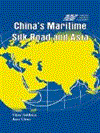

|
|
|
|
|
| Publication |
New Delhi, Vij Books India Pvt Ltd, 2016.
|
| Description |
xv, 147p.hbk
|
| Standard Number |
9789384464981
|
|
|
|
|
|
|
|
|
|
|
|
Copies: C:1/I:0,R:0,Q:0
Circulation
| Accession# | Call# | Current Location | Status | Policy | Location |
| 058403 | 359.00951/SAK 058403 | Main | On Shelf | General | |
|
|
|
|
| 11 |
ID:
146378
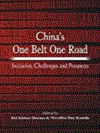

|
|
|
|
|
| Publication |
New Delhi, Vij Books India Pvt. Ltd, 2016.
|
| Description |
xiv, 117p.hbk
|
| Standard Number |
9789385563591
|
|
|
|
|
|
|
|
|
|
|
|
Copies: C:1/I:0,R:0,Q:0
Circulation
| Accession# | Call# | Current Location | Status | Policy | Location |
| 058756 | 327.51/SHA 058756 | Main | On Shelf | General | |
|
|
|
|
| 12 |
ID:
153519
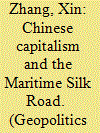

|
|
|
|
|
| Summary/Abstract |
As China tries to catch up from a semi-peripheral status in the hierarchy of a capitalist world-system, three decades of fast economic growth have recently shown serious signs of capital glut, overproduction and decreasing returns to capital, indicating the beginning of a phase of contraction and stagnation in the long-cycles of capitalist accumulation. The combination of “capital logic” and “territorial logic” in Giovanni Arrighi’s framework gives both the Chinese state and Chinese capital strong incentives and pressure to actively engage in a “spatial fix” by reconfiguring its geographic vision in order to further capital accumulation and expansion on a larger spatial dimension, culminating in the “One Belt, One Road” Initiative, including the Maritime Silk Road Initiative (MSRI). The official promotion of the MSRI hopes to revitalise the historical precedents of the “Silk Road” so that the modern-day hyper-connectivity across Asia, Africa and Europe will facilitate the formation of a China-led reorganised world economy, operating under open and equal participation, possibly leading to common development for all countries involved. However, the nature and impact of such a grandiose initiative, especially its core mission of “connectivity”, is still highly contingent on the hybrid nature of Chinese capitalism in the world-system and how China engages capitalism at the global scale.
|
|
|
|
|
|
|
|
|
|
|
|
|
|
|
|
| 13 |
ID:
154438
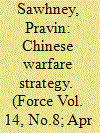

|
|
|
| 14 |
ID:
164432
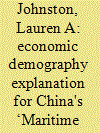

|
|
|
|
|
| Summary/Abstract |
For four decades, China has gradually re-shaped the distribution of global economic activity, underpinned by a low-wage demographic dividend era. For around a decade, however, both demographic and economic structural change, at home and abroad, have incrementally shifted China's comparative advantage away from low-wage industrialisation. In response, China now seeks to become an international investor in these industries under the umbrella of the country's flagship Belt and Road Initiative. That set of changes, in turn, offers a new context of opportunity for developing countries, and especially so for Indian Ocean (IO) countries that are strategically placed along a continental coastline and in the early phase of a process of demographic transition. This explains the economic demography imperative underlying China's twenty-first-century interest to deepen economic ties with IO countries under the umbrella of the 'Maritime Silk Road of the twenty-first century' initiative.
|
|
|
|
|
|
|
|
|
|
|
|
|
|
|
|
| 15 |
ID:
163382
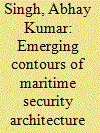

|
|
|
|
|
| Summary/Abstract |
The revival of the centuries-old ‘Silk Road at Sea’ into a 21st Century Maritime Silk Road (MSR) is an integral part of China’s ambitious Belt and Road Initiative (BRI). The Chinese White Paper on its vision for enhancing maritime cooperation broadly confirms this perception, since it considers maritime security assurance as the lynchpin of MSR initiatives. As its trade and overseas economic interests have been constantly growing, Beijing’s strategic concern about protection of these interests has magnified. This article argues that through the assurance of maritime security under a cooperative framework as an ‘international public good’, China, via the expansion of its maritime influence in the IOR, aims to play a proactive role in shaping the maritime strategic environment.
|
|
|
|
|
|
|
|
|
|
|
|
|
|
|
|
| 16 |
ID:
147985
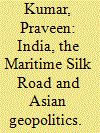

|
|
|
|
|
| Summary/Abstract |
Paul Kennedy, the author of The Rise and Fall of the Great Powers in one of his later works, entitled Preparing for the Twenty-First Century has argued that India and China can potentially do harm to themselves and the planet, given their rising population and limited resources. He has urged upon the developed world to “apply its capital, technology and brainpower to help them.” While there may be limitations to this argument, first being a western perspective and then on considerations such as with regards to the extent to which the developed world intends helping India and China, and to what extent India and China are willing to accept the terms, if any, of that help, but one thing that the author has highlighted is of significance. This pertains to the likely ‘conflict of interests’ over common resources and market between the two countries.
|
|
|
|
|
|
|
|
|
|
|
|
|
|
|
|
| 17 |
ID:
149286
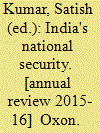

|
|
|
|
|
| Publication |
Oxon, Routledge, 2016.
|
| Description |
xvii, 442p.: ill.hbk
|
| Standard Number |
9781138282841
|
|
|
|
|
|
|
|
|
|
|
|
Copies: C:1/I:0,R:0,Q:0
Circulation
| Accession# | Call# | Current Location | Status | Policy | Location |
| 058900 | 355.033054/KUM 058900 | Main | On Shelf | General | |
|
|
|
|
| 18 |
ID:
141032
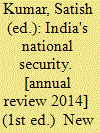

|
|
|
|
|
| Edition |
1st ed.
|
| Publication |
New Delhi, Routledge, 2015.
|
| Description |
xviii, 493p.: ill.hbk
|
| Standard Number |
9781138191273
|
|
|
|
|
|
|
|
|
|
|
|
Copies: C:1/I:0,R:0,Q:0
Circulation
| Accession# | Call# | Current Location | Status | Policy | Location |
| 058325 | 355.033054/KUM 058325 | Main | On Shelf | General | |
|
|
|
|
| 19 |
ID:
153186
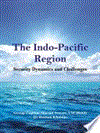

|
|
|
|
|
| Publication |
New Delhi, Vij Books India Pvt Ltd, 2016.
|
| Description |
xxiii, 172p.hbk
|
| Standard Number |
9789385563706
|
|
|
|
|
|
|
|
|
|
|
|
Copies: C:1/I:0,R:0,Q:0
Circulation
| Accession# | Call# | Current Location | Status | Policy | Location |
| 059084 | 355.033091824/TEW 059084 | Main | On Shelf | General | |
|
|
|
|
| 20 |
ID:
190950
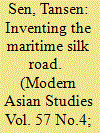

|
|
|
|
|
| Summary/Abstract |
Although inspired by the nineteenth-century term ‘Silk Road(s)’, the phrase ‘Maritime Silk Road’ has its own origins, connotations, and applications. This article examines the emergence of the latter term as a China-centric concept and its various entanglements since the early 1980s, involving the People’s Republic of China’s (PRC) political bodies, academia, the ‘open door’ policy, the pursuit of World Heritage listings, and the current ‘Belt and Road Initiative’. These entanglements, the article contends, have resulted in the emergence of what could be called a ‘Maritime Silk Road’ ecosystem in the PRC. The analysis of this ecosystem presented in the article reveals not only the processes through which a narrative on China’s engagement with the maritime world has been constructed over time, but also its association with issues of national pride, heritage- and tradition-making, foreign-policy objectives, and claims to territorial sovereignty. As such, the ‘Maritime Silk Road’ must be understood as a concept that is intimately entwined with the recent history of the PRC and distinct from its nineteenth-century antecedent, which was used as a label for overland connectivity.
|
|
|
|
|
|
|
|
|
|
|
|
|
|
|
|
|
|
|
|
|